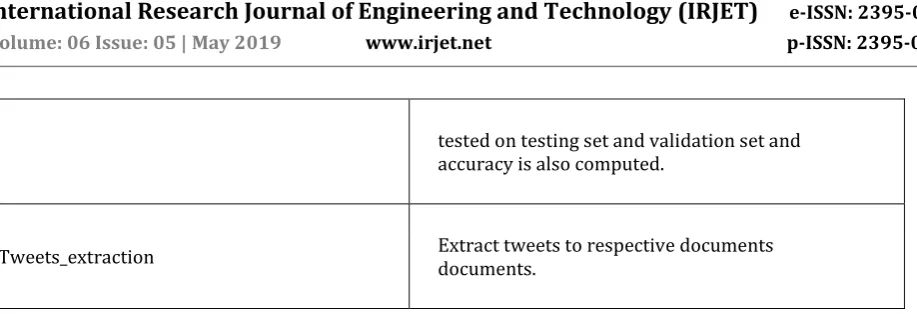© 2019, IRJET | Impact Factor value: 7.211 | ISO 9001:2008 Certified Journal
| Page 4746
SENTIMENT ANALYSIS USING TWITTER DATA
Kirti Jain
1, Abhishek Singh
2, Arushi Yadav
31
Asst. Professor, Dept. Of Computer Science, Inderprastha Engineering College
2, 3Student, Dept. Of Computer Science, Inderprastha Engineering College
Dr. A. P. J. Abdul Kalam Technical University
---***---Abstract -
Sentiment analysis as the name suggest it is the analysis of the sentiments/feelings/expression related to any
topic, it is also known as opinion mining. Here the motive is to find the general sentiment associated to given document. We try to classify the subjective information gathered from some microblogging site according to its polarity such as positive, neutral and negative using machine learning and natural language processing. In this project, we chose Twitter as the microblogging source for getting peoples sentiments and try to classify the tweets into positive, neutral and negative sentiment.Key Words: Sentiment Analysis, Polarity, Machine Learning, Natural Language Processing, Twitter, Microblogging.
1.INTRODUCTION
Sentiment analysis studies people judgment or thought towards certain entity. Twitter is a resourceful place to find people sentiment. Here peoples post their thought/experience/ feelings through tweets which has a character limit of 140. Twitter has a provision for developers to collect data from twitter by releasing their APIs. In this project we are using one of the twitter API i.e. streaming API which helps to extract the content in the real time.
Here we perform the linguistic analysis by building the classifier using the several machine learning techniques and natural language processing by using the collected corpus from the Kaggle as the training data to train our classifier and use the streamed corpus as the testing data to test the result of our classifier to classify the different sentiments related to tweets.
In this project we focus on the tweets related to airline as the customer shares their experience on the twitter thorough their tweets and our analyzer helps the airline company to improve their services by keeping an eye on people’s sentiments by overcoming their flaws.
[image:1.595.41.557.586.741.2]2. LITERATURE REVIEW
Table -1: Literature Survey Table
S.
NO Paper Title Authors
y e a r
Methods Remarks
1. Sentiment Analysis on Twitter Data Varsha Sahayak, Vijaya Shete, Apashabi Pathan
2 0 1 5
Naïve Bayes, Maximum Entropy, SVM
© 2019, IRJET | Impact Factor value: 7.211 | ISO 9001:2008 Certified Journal
| Page 4747
2. Sentiment Analysis on Twitter Data Onam Bharti, Mrs. Monika Malhotra
2 0 1 6
Naïve Bayes, KNN
Accuracy (%)
Naive Bayes- 79.66
KNN – 83.59
3. Sentiment analysis of twitter data Hamid Bagheri, Md Johirul Islam 2 0 1 7
Naïve Bayes, Text Blob
We realized that the neutral sentiments are significantly high which shows there is a need to improve Twitter sentiment analysis.
4.
Study of Twitter Sentiment Analysis using Machine Learning Algorithms on Python Bhumika Gupta, Monika Negi, Kanika Vishwakarma, Goldi Rawat 2 0 1 7 Bayesian logistic regression ,Naïve Bayes, Maximum Entropy Classifier , Support Vector Machine Algorithm
This research topic has evolved during the last decade with models reaching the efficiency of almost 85%-90%. But it still lacks the dimension of diversity in the data. Along with this it has a lot of application issues with the slang used.
5.
Sentiment Analysis of Twitter Data through Big Data
Anusha.N, Divya.G, Ramya.B 2 0 1 7 Naïve Bayes Classification, Training with Mahout
After the training set has been prepared, data is analyzed by uploading it on HDFS and Naïve Bayes classification is carried out. 6. Machine Learning-Based Sentiment Analysis for Twitter Ali Hasan, Sana Moin, Ahmad Kari and Shahaboddin Shamshirband 2 0 1 8 Naïve Bayes Classifier, SVM Classifier
This paper focuses on
the adoption of
machine-learning
algorithms to
© 2019, IRJET | Impact Factor value: 7.211 | ISO 9001:2008 Certified Journal
| Page 4748
3. CORE MODULES
[image:3.595.54.538.168.797.2]These are the modules which are used in our project along with their functions are given in the table below:
Table -2: Core Modules
MODULES FUNCTION
Twitter_data_streaming It uses tweepy module for streaming live tweets using Oauth Handler.
Create_dataset It creates training and testing data set from the dataset downloaded from kaggle.
Create_validation_dataset Using the tweets downloaded, validation dataset is generated.
Feature_extraction_word2vec Finds most similar words present in file.
Term_frequency Feature extraction using TF-IDF(term frequency–inverse document frequency)
Term_frequency_computaion Feature extraction using bag of words approach
Naïve_bayes_Classifier Building classifier using naïve bayes algorithm
SVM_classifier Building classifier using SVM approach
Data_setup_neural_network It adds weight, if positive then 1 then if negative then 0 if neutral then 2
Neural_networks Using training data set creates a model using backward propagation and predicts the results i.e. by improving weights
© 2019, IRJET | Impact Factor value: 7.211 | ISO 9001:2008 Certified Journal
| Page 4749
4. RESULT
In this section we present the results of our three classifier i.e. Naïve Bayes, SVM, Neural Network.
[image:4.595.79.538.50.207.2]The accuracy of all the three classifier is computed and shown below:
Table -3: Results
As the SVM has the highest accuracy that’s why we use this classifier to classify our tweets and the
result is as follows:
tested on testing set and validation set and accuracy is also computed.
Tweets_extraction Extract tweets to respective documents documents.
Classifier Accuracy (%)
SVM Classifier 81.57
Naïve Bayes 71.05


